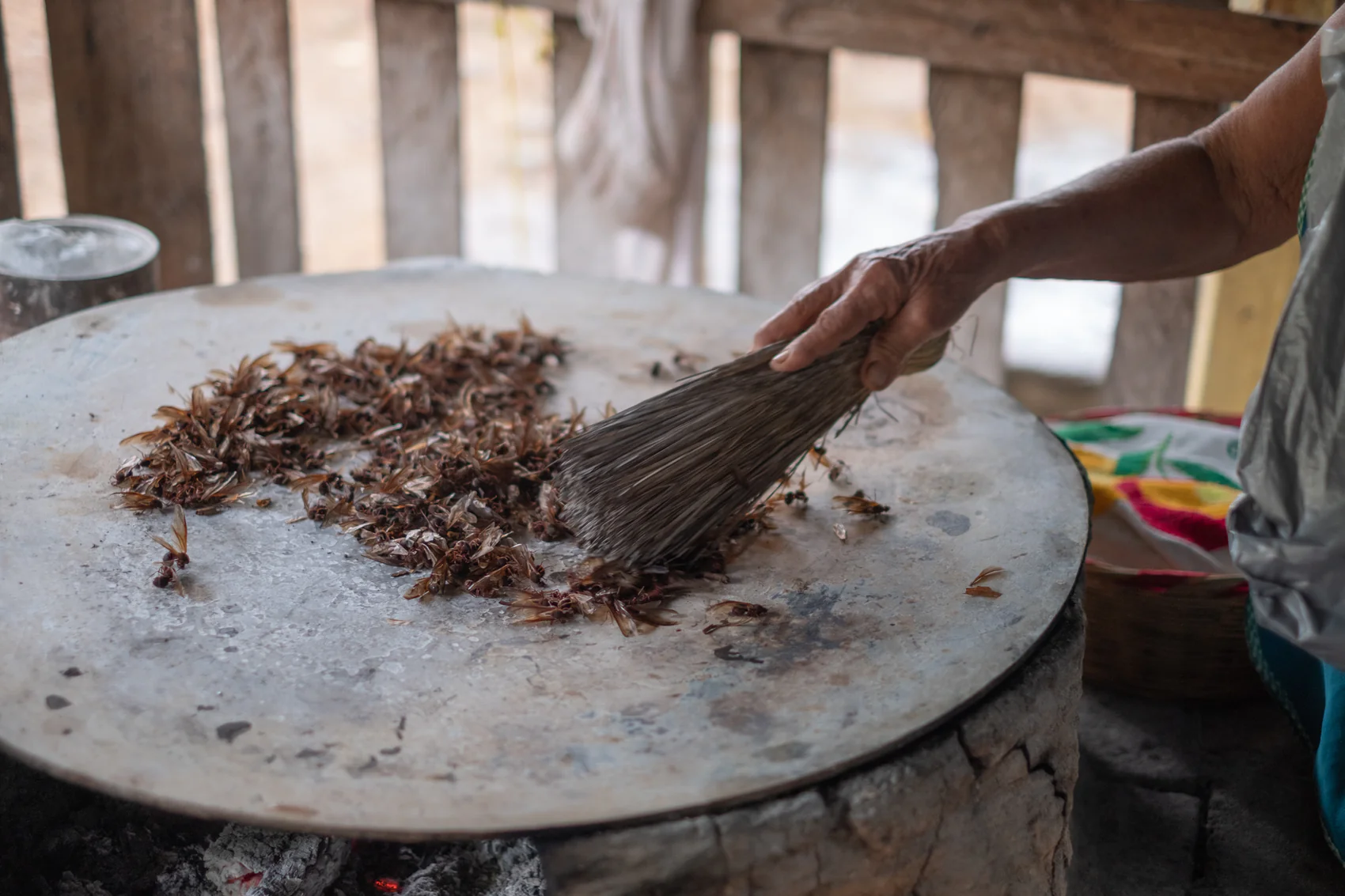The Quest for Chicatanas
The Quest for Chicatanas

June 22, 2022
Chicatana ants are an incredibly rare Mexican delicacy, richly flavorful and challenging to harvest. Foraged by hand in select parts of the country, during the first major rains of late spring and early summer, they can only be gathered in an exceedingly narrow region within an even narrower window of time. With the combination of generations of knowledge of these fickle creatures, the right weather conditions, and a not-insignificant amount of luck, our partners in Oaxaca were able to procure Masienda Chicatanas from various communities within the coastal region.
Lucky for us, our still photographer Alejandro López Pineda and DP Alex Roa were able to join the Ramírez family in Santiago Cuixtla, Oaxaca to capture the fleeting harvest. Watch the video, and take a look at Alejandro's beautiful photo-essay to learn more about the experience and what makes these edible insects so special.
The Quest for Chicatanas
Photography and text by Alejandro López Pineda.
There is a certain mysticism around the number three in everything from religious texts to video games; it might have something to do with nature. In the case of the flying-ant-turned-luscious-delicacy, the chicatana ant, three is the magic number of rainy days one should wait to gather them.
I’m talking to Ciriaco, the taxi driver taking us deeper into the tropical forest and further away from the Puerto Escondido beaches in Oaxaca, Mexico. It’s late: our flight from Mexico City was delayed and it's dark already. It looks like it’s going to be a long night.
He explains to me and Alex the strength of the bite of the arriera ants, the ones that protect the chicatana ants when they exit their nests: “they can tear your skin off,” he says. I’m wearing shorts.

Ciriaco, our driver, taking us deep into the tropical forest.
He laughs loudly.
Ciriaco: “Are you gonna be wearing shorts?” He laughs again. I’m just looking at my outfit.
Ciriaco: “Well, it’s going to be fine.“
Me: “But you just laughed.”
Ciriaco: "Because wearing shorts, you won’t last a minute."
All I can think of is offering to buy the trousers he is wearing off of him. He then tells us that we might be able to also catch chicatanas just using light (a flashlight or the car headlight). If we turn any of those on, the chicatanas will just follow the light and we will be able to capture them. I’m still not feeling any kind of relief.
Chicatana gathering is a tradition in the coastal region in Oaxaca and some other states in Mexico. Kids do it for fun, and nowadays it is also an important source of income for the people that live nearby the nests. We arrive to Santiago Cuixtla after a couple of hours in the cab.

Yaz waits for us at her home in Santiago Cuixtla, Oaxaca.
Yaz receives us. She is very excited to be able to capture some chicatanas and to have pictures and video footage of the process—a very tedious and exhausting one, to be honest. We meet her aunt as well, and I store my luggage consisting of a pair of sandals, two tank tops and a jacket. I have never felt so unprepared for anything in my entire adult life.
Still, I’m already there. Alex, my filmmaker colleague, is there as well, so, we unpack our cameras and gear and meet Yaz downstairs, where she is having an argument with her aunt.
Aunt: “They are not coming out tonight."
Yaz: “Yes, they are, today is going to be the third rain, they’ll come out."
Aunt: “Today it will not rain, they won’t come out.”
Yaz is eager to prove her aunt wrong. Alex and I have learned the hard way that when an elder says something like that, they are usually right, but our hopes are with Yaz as well. It’s almost midnight and we have to get some rest, at least enough to complete a REM cycle before we wake up and start hunting for those delicious treats.
It has to be done at night, because as soon as the sunlight comes out, chicatanas will just fly away. Some of them will be eaten by birds and other animals, others will fly back to their nests and stay there for another year. Yes, it is true what they say, this happens but once a year.
It has to rain three times, the first three rainy days of the rainy season. There is no way to know for sure when this will happen—climate change and global warming are affecting these cycles and Nature has no calendars or friendly Alexa reminders to know for sure when to push chicatanas off their nests. Fortunately, Nature remains wise.
The two days before our arrival, it rained a lot. Chicatanas were ready to leave their self-built homes.
Alex and I wake up, he lends me some pants, they fit, so we are ready to go. It’s 3am and we wait for Yaz and her friends to take us to the chicatana nests. We hop on a pickup truck and begin the journey.

Gabriel is driving us, and Alma comes along. We need to drive some kilometres away from the town to find chicatanas.
Our first stop is a dead end. Sergio and Leodegaria, a family living ten minutes away from the town center, have some chicatana nests. They tell us that the day before, they captured some, but it was nothing like the year before, when they collected like 8 kilos of the savory insect.
We take a look at the nests but there is nothing there. Time is running out and we need to find another nest before sunrise. We say goodbye and head towards another nest.

Yaz and Don Sergio use their flashlights to see if there are any chicatanas left in Sergio’s field crops
On our way, we find a couple of locals with flashlights exploring a field crop. They are hunting for chicatanas as well but are not having any luck. Yaz is beginning to show signs of despair and disappointment. It turns out it did not rain that night, which basically means the ants won’t come out, not until the third rain, which might be . . . nature only knows.
We stop at another place. There is no light in the road. It seems like we just stopped so we could feel that we tried. Gabriel comes back after exploring a bit. He tells us he couldn’t see any arriera ants (when chicatanas are coming out, you can see lots of arrieras around the nests).

We went through every chicatana nest Yaz knew about.
Yaz lowers her head. I gently remind her what her aunt said, and she nods at me. We get back on the truck and head back to the town.
Gabriel stops again. It’s already 5am, the sun is one hour away. Yaz explores along with Gabriel using her cellphone light. We just wait. Everyone looks sleepy. Someone should have listened to the elders; none of us did. And then Yaz comes back.

It’s getting late and it seems like we are not going to find any chicatanas tonight.
Yaz: “We found some!”
We all get off the truck and head to where Gabriel is waiting.
The next five minutes are the slowest “suit up” action scene the world has ever seen. We put on some long socks over our pants, we put on our jackets, tighten our boots, stretch arms and legs, and put fresh batteries in our cameras. We are ready to see some ant action. Alex and I are about to find out whether we did everything properly or not.
Alma, Yaz and Gabriel look at me and Alex: we look like proper foreigners afraid of losing our skin to the fierce bites of the arriera ants. They have done this many, many times before, so they are already aware of what is about to happen.
With the help of nothing but cellphone flashlights (we couldn't use the video light Alex brought because it could scare off the chicatanas), we walked into the field slowly, being careful not to step on the chicatana nests, and there they were!

Yaz and Alma begin gathering as much chicatanas as they can and putting them in plastic bags.
Yaz kneels and captures a Chicatana ant. She shows it to us — it is this huge, winged, black, fat ant. She puts it in her hand and suddenly she starts jumping around. She is trying to get rid of of the arriera ants that are crawling all over her shoes. I look at my shoes: there are ants all over my legs.

Yaz hurries to capture as many chicatanas as she can, and Alma does the same. Gabriel decides to go get a bucket; he is going to show us how they captured chicatanas back in the day. It is becoming some sort of ritual dance as everyone moves around the nest. We all try not to get bitten by the arriera ants while Yaz and Alma gather all the chicatanas they can get their hands on.
People say these arriera ants basically exist to prepare the way for the chicatanas. They protect them, fiercely, and we could tell in that moment those ants were not going to make it easy for us to capture anything but painful bites.
Gabriel comes back with a wide bucket. He places it right next to one of the chicatana nests, pours some water in it and takes off his sandals to step into the bucket. It actually works. He starts grabbing chicatanas.

Meanwhile, everyone else has arriera ants all over our shoes and pants, and they are starting to get into our backs. We have to stop to get rid of them—their bite is really strong and it’s almost sunrise. Our time is up.
Suddenly, as if by magic, the arrieras go back to their nest and we no longer see chicatanas anywhere. Yaz and Alma seem satisfied with the collection: they calculate around 800 grams of chicatanas between both of their bags.
As we head back to town, the sunrise is coming. Everyone tries to shake off any arriera ants left in our clothes.
There is a mood shared by everyone in the truck of satisfaction and accomplishment. It’s 6am and we need to rest.

Doña Cristina has already finished making tortillas and every other thing she might need for breakfast. The comal is cooling down slowly; she puts out her hand to feel the temperature. It’s time to put the chicatanas out to dry. Yaz gives her the bag and Cristina scatters the chicatanas in the comal.
Slowly and gently, Doña Cristina stirs the chicatanas. It is a delicate process; she seems to be enjoying it. I am mesmerized by it—it's so thorough and so precise that I almost forget I only slept a couple of hours and have not had coffee yet.
The wings start coming off and Cristina just blows them away. She keeps stirring until it's time to clean them. Cristina removes the chicatanas from the comal, putting them in a plate, then sweeps the comal and takes the ants outside. She throws them up, then catches them in the plate, once and again: this makes the wings and legs fall away from the chicatanas.

Chicatanas get roasted in the comal using low heat. The wings start floating around as Doña Cristina slowly brushes the chicatanas.
She puts them in the comal again: they have to be perfectly dry to be stored so they can reach their final destination. Cristina looks at us and asks whether we would like to taste them. Easiest question to answer ever.
She begins roasting some avocado leaves and some chiles.
Cristina: “The onion shouldn’t be roasted, this salsa is prepared just like this.”

We are not going to argue with elder, master-chef knowledge; we just patiently wait for the result. Cristina then washes some chicatanas and puts them in a molcajete along with the roasted chiles, avocado leaves and the onion. She grinds them together with some salt, then she heats some handmade tortillas and makes a taco. It tastes like heaven.
In Santiago Cuixtla, chicatanas are used in salsas, tamales and mole, in recipes that vary amongst each household.
I wake up after a nap. It’s the evening and it has not rained; there might not be any chicatanas tonight. It seems like what we saw the day before was nothing compared to the big chicatana event that happens every year.
Yaz tells us we are going to try anyway. She asks us to go get some sleep, and says she will wake us up as soon as she finds a proper nest, around 3am, she thinks.
When Alex’s phone rings, we’re both ready, but there aren’t any ants. It feels like a failure. We head back to Mexico City the next day, missing the big event.
We wake up early in the morning: the fire stoves are being lit. There is almost no one to be seen in the small town, and the scent of firewood starts to spread around every corner coming from almost every kitchen. We arrive to where Doña Cristina is cooking breakfast for her family.
It is Sunday and almost every Mexican will go visit their relatives. Doña Cristinas’ house is a proper party, a celebration for the senses and the heart. Everyone talks about what happened throughout the week, at school, at work, the harvest, some neighbor, the neighbor’s cousin, the weather. Some of them are cooking, others are eating. An uncle walks in carrying a really big shrimp, and Doña Cristina puts it in the comal.
Yaz: “There is some chicatana salsa.”

Yaz puts a small plastic container with freshly made salsa on the table. A small kid uses a spoon to pour some salsa in his picadita—a freshly-made, thick tortilla fried with lard and served with beans, red salsa and cheese. Another kid pours the chicatana salsa in his enchilada. It’s a feast.
I talk to Don Emiliano, Doña Cristina’s husband. “Chicatanas are fleeting,” he says. The first time he saw them he was six; today he is 80. Back in his day, there was no other way to leave the town but by walking. People used to travel for days to the cities to sell some of their products.
At night, they would sleep over in the middle of the tropical forest. That’s how they encountered chicatanas right after the first rainy days of the summer: they saw them flying around and began capturing them.
"It is a tradition," Don Emiliano tells me. He explains that everyone in these communities used to capture them for self-consumption. Now they also sell them and it's become not only an important income source but also a way for families to get together and share a unique experience and a rare delicacy.

After canceled flights, over-booked hotels, blackouts and a hurricane that stranded me for four days in the Oaxacan coast, I'm finally on a plane heading back to Mexico City.
I’m looking at all the pictures Yaz sent me from the chicatana gathering: children chasing them in the streets, women sweeping them from their backyards. The hurricane turned out to be the third rain, the one the ants were waiting for. And I was locked away in a hotel room thinking I was going to die, missing out on the big chicatana event.
When I first arrived at Santiago Cuixtla, I wondered why I had never heard about the chicatana ants. I finally understand what Don Emiliano meant when he said they were fleeting, impermanent. It almost seems like being able to witness them, not to mention capture some, might be a stroke of pure luck. Now I know it’s more complex than that. You need a combination of knowledge, patience, faith and perseverance. It takes a lot to become a chicatana gatherer.
Find the recipe for our favorite salsa de chicatanas here.




All Comments
Hi Xochil, thank you for your comment! Here’s a delicious recipe using chicatanas: https://masienda.com/blogs/learn/chicatana-salsa-recipe. ¡Provecho!
I would love to see a recipe to accompany the item. I really want to use it in my cooking